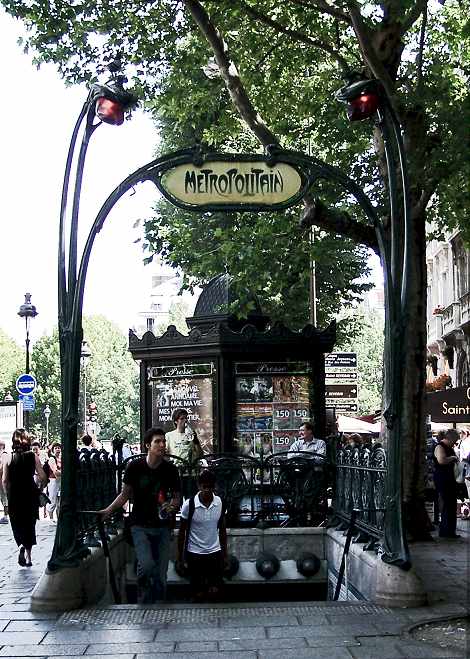6 th arrondissement, Paris - Paris-Pages.comPalais du Luxembourg , Luxembourg Gardens, restaurants in the 6thnext page |
|
 |
 Right, the entrance to the metro at St. Michel. This is one of the original entrances designed by the famous Art Nouveau architect Hector Guimard. 82 of the original iron entrances survive. |
Place Saint-Micheland Boulevard St. MichelAbove, the fountain in Place Saint-Michel. Next to the St. Michel metro (right), this makes a popular meeting place. The statue shows St Michel crushing a dragon and is by Duret; the fountain is by Davioud. As you stand looking at the fountain there is a maze of tiny streets across Boulevard St. Michel to your left. There are hundreds of Greek restaurants and kebab places, and the whole place is a bit of a tourist trap, however have a walk around as the buildings are very old and interesting. On this side of the fountain I can highly recommend La Lozere in rue Hautefeuille for either lunch or dinner. Boulevard St. Michel forms the boundary between the 6th and 5th arrondissements. During the liberation of Paris from the Germans in August 1944 there was quite a lot of gunfire in this area, and many of the cafes had bullet holes in their windows. They left the windows as they were, though, as a sign of pride. |
 |
 |

Above a statue of Denis Diderot in the Boulevard St Germain. Arts and literature in the 6th arrondissementThe 6th is full of literary and artistic significance. The very ordinary house below used to be a bookshop called Shakespeare & Co. It was founded by the poet Sylvia Beach in 1919. It sold both new and second-hand books, and counted Hemingway, Scott Fitzgerald, Ezra Pound and James Joyce among its customers. In 1922 the novel Ulysses by James Joyce was published here, as is indicated on the plaque. More recently Shakespeare & Co has moved to 37 rue de la Bucherie, and is run by a grandson of Walt Whitman. |
St. Germain des PresLeft and above, inside St. Germain des Pres, the oldest church in Paris built in the 11th century. The chancel dates from the 12th, and the porch from the 17th, but the tower and nave are still the original. Before Notre Dame was built St. Germain des Pres was the dominant church in Paris. Much of the inside of the church still has the stonework painted as was normal in those days, see the pillars on the left. Imagine how the people must have felt coming from their single storey drab wood, thatch and mud houses into this huge, colorful stone building. No wonder they believed in miracles. Next to the church is the famous cafe Les Deux Magots, a good place to sit and watch the world go by. |
|
|
Gertrude Stein lived from 1903 -1938 in 27 rue de Fleurus, just off the Luxembourg Gardens, and from 1838 until her death in 1946 in 5 rue Christine, both in the 6th. She coined the phrase "the lost generation" after talking to the garage owner who worked across the street, who complained that his young workers were "un generation perdu". Her apartment was full of paintings by Picasso, Cezanne and others, and a place of warmth and refuge for starving writers between the wars. In August 1944 when the Germans were retreating from Paris they came to rue Christine to loot her paintings. The neighbours called the police who bravely demanded to see written proof that the Germans had authority to take away the paintings. The Germans left with nothing. Gertrude Stein spent the years of WWII in the south of France, close to the Swiss border, and though a Jew the local mayor kept her name off the lists he was obliged to supply to the Vichy authorities. Far left is the stature of Honore de Balzac by Rodin in Place Pablo Picasso. |
 |
 |
copyright2003-2012 |




